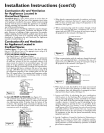
installation instructions
:illing the Water Heater
(cont'd)
I ACAUTION
Never use this water heater unless it iscompletely filled with
water. To prevent damage to the tank, the tank must be filled
with water. Water must flow from the hot water faucet
before turning "ON" gas to the water heater.
To fill the water heater with water:
• Close the water heater drain valve by turning the handle to
the right (clockwise). The drain valve is on the lower front of
the water heater.
• Open the cold water supply valve to the water heater.
NOTE: The cold water supply valve must be left open
when the water heater is in use.
" To insure complete _lling of the tank, allow air to exit by
opening the nearest hot water faucet, Allow water to run
until a constant flow is obtained. This will let air out of the
water heater and the piping.
• Check aHnew water piping for leaks. Repair as needed.
Venting
] AWARNING
I VENT DAHPERS - Any vent damper, whether it is operated
&ermally or otherwise must be removed ifits useinhibitsprop-
er drafting of the water heater.
Thermally Operated Vent Dampers: Gas.fired water heaters
havingthermal efficiencyin excessof 80% may produce a rela-
tively low flue gastemperature. Suchtemperatures may not be
high enough to properly open thermally operated vent
dampers. This would causespillage of flue gasesand may cause
carbon monoxide poisoning.
Vent dampers must bear evidence of certification ascomplying
with the latest edition of American National Standard ANSi
Z21.68 (ANSI Z21.66 & 67, respectively, cover electrically and
mechanically actuated vent dampers). Before installation of any
vent damper, consult your local SearsService Center or the gas
utility for further information.
AWARNING
To insure proper venting of this gas.fired water heater, the
correct vent pipe diameter must be utilized. Any additions or:
deletions of other gas appliances on a common vent with this
water heater may adversely affect the operation of the water !;
heater. Consult the local Sears Service Center or gas utility if _
any such changes are planned.
For proper venting in certain installations, a larger diameter vent
pipe may be necessary. Due to great variances in installations,
unforeseeable by the manufacturer of the water heater, you must
consult your gas company to aid you in determining the proper
venting for your water heater from the vent tables in the latest
edition of the Nationa! Fuel Gas Code ANSI Z223.1, also
referred to as NFPA 54.
Check the venting system for signs of obstruction or deterioration
and replace if needed.
The combustion and ventilation air flowmust not be obstructed.
AWARNING
Obstructed or deteriorated vent systemsmay present a serious
health riskor asphyxiation.
" Place the draft hood legs in the receiving holes on the top of
the water heater. The legs will snap in the holes to give a tight
_t.
• Place the vent pipe over the draft hood. With the vent pipe in
position, drill a small hole through both the vent pipe and
draft hood. Secure them together with a sheet metal screw.
VENT_._ $
I '_' i
I
L VENT TO OUTDOORS OR
DRAFT I_O_ CH_x_NEY
AWARNING
The water heater with draft hood installed must be properly f
vented to a chimney which terminates outdoors. Never oper- I
ate the water heater unlessit is vented to the outdoors and hast
adequate air supplyto avoid risksof improper operation, explo-
sionor asphyx_ion. l
AWARNING l
The vent pipe from the water heater must be no lessthan the I
I diameter of the draft hood outlet on the water heater, and I
must slope upward to the chimney at least ¼ inch per linear l
foot. /
13


















